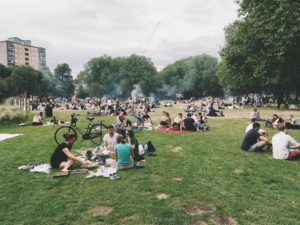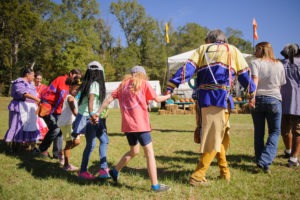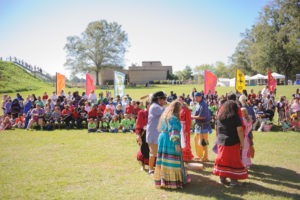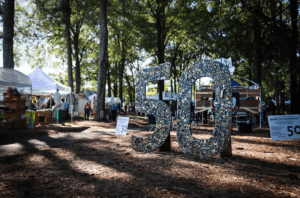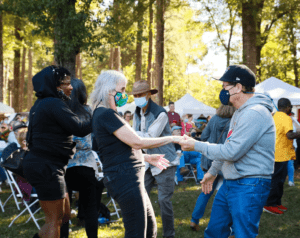A Year of Work for One Event: Communication Practitioners and Annual Festivals
Published on Nov. 14 at 4:15 p.m.
by Annabelle Blomeley.
Across the United States, there are more than 800 music festivals, 8,000 art festivals, 1,800 film festivals, 7,000 food festivals and thousands of other festivals outside of the mentioned categories.
With special events and festivals dating back millennia, it’s no wonder why they continue to hold strong today. In the communications and public relations industry, events can be important ways to expand audiences, engage with communities, and affect opinions about your business or organization.
The most important part of an event is the patrons who attend, which is where communication specialists — such as public relations practitioners, advertisers and marketers — become very important members of the festival ecosystem.
While some festivals and large-scale events are put on by organizations to engage with their priority publics, others are the catalyst for their entire organizations, starting out as a few people with a dream to celebrate something with likeminded people and turning into something bigger.
With travel and tourism contributing nearly $5.8 billion to the United States GDP every year, festivals and events are only growing, meaning the need for communication specialists who know how to meet the needs of the event is increasing as well.
Moundville Native American Festival
In Moundville, Alabama, an ancient city once inhabited by Mississippian Native Americans now stands as Moundville Archaeological Park, welcoming visitors year-round. Known today as the largest prehistoric Native American settlement in the United States, Moundville has a rich history and story that continue to be told at the Moundville Native American Festival.
Rebecca Johnson, the communications specialist for The University of Alabama Museums, does the advertising, marketing and public relations work for all five of the University’s museums, including Moundville Archaeological Park.
From managing social media accounts and writing press releases to creating Google Business event listings and making branded deliverables, Johnson has several events per year to work on, such as the Moundville Native American Festival, Bama Bug Fest and National Fossil Day.
With Bama Bug Fest in second place at 1,700 attendees, Johnson said the Moundville Native American Festival is by far UA Museums’ largest event, often having approximately 8,000 visitors in the span of four days in October.
Johnson said she changes her strategies to reflect a larger audience and a larger budget for the Native American Festival. On top of her normal communication tactics, Johnson adds radio advertising, magazine advertisements with ticket giveaways, billboards around Tuscaloosa and additional paid social media ads.
For UA Museums, events like the Moundville Native American Festival put more eyes on UA Museums as a whole, including all of its other programming.
“One of the things that we are working towards here at UA Museums is a general awareness to the public about the fact that The University of Alabama not only has museums but has a museum system,” Johnson said. “With every event we do, every exhibit that we do, we’re trying to work towards that goal so that people know that we exist.”
While UA Museums uses events like the Moundville Native American Festival to increase its audience and engage with the community, other organizations began as a single event and bloomed into much more.
Sidewalk Film Festival
In the streets of downtown Birmingham, Alabama, thousands of cinephiles meet for one week out of the year to watch some of the best films created by Alabama natives at the annual Sidewalk Film Festival. Everyone from movie buffs to casual moviegoers watch films, eat meals bought from food trucks, and get away from the Alabama summer heat in the impressive theaters of the city.
Since the first festival in 1999, Sidewalk has grown as both a festival and nonprofit dedicated to “encouraging filmmaking in Alabama and building audiences for independent film.” Today, the film festival features more than 250 filmmakers and welcomes 15,000 visitors to Birmingham each year.
Nick Adrian, the marketing manager for Sidewalk Film Festival, said his job at the nonprofit combines his love of film and media with his passion for digital marketing.
For the Sidewalk team, Adrian said the last week in August is like “Christmastime for a retail store.” Although he’s busy throughout the summer working on the festival, the Sidewalk team works the entire year to perfect their communications for both the event and the nonprofit.
With so many moving parts, Adrian’s communication strategies must constantly change depending on the programming and time of the year. From booking radio shows and television news coverage to writing press releases and managing Sidewalk’s social media accounts, Adrian is busiest in the months leading up to the festival.
But Adrian’s work isn’t done once the festival begins. Sidewalk Film Festival works as its own advertising and marketing agent by ensuring that attendees have a good time and spread the word. By documenting the great time everyone is having, Adrian can use the festival content throughout the year to expand the festival’s audience.
“I think just people posting on Facebook and Instagram and seeing how much fun these other people are having at these events pushes them to be like, ‘Oh, I should have gone to this,’ or ‘Maybe there’s still a chance for me to go to that.’ It really is like a community-driven thing,” Adrian said.
While this all may seem like a lot of work for Adrian, other parts of Sidewalk Film Festival help push the mission for the nonprofit while also providing year-round programming.
In late 2019, the nonprofit opened the Sidewalk Film Center and Cinema, a venue and movie theatre in the heart of downtown Birmingham that has continuous movie showings. Sidewalk hosts other film weeks as well, including Black Lens Film Week, Shout LGBTQ+ Film Festival, Women in Film Week and Jewish Film Week, which starts on Nov. 13.
Adrian said the year-round programming also acts as communications for the festival, since people may come to the cinema and leave with newfound knowledge about everything Sidewalk does. In this way, the festival brings new people to the cinema and other events, so the entire nonprofit works as a well-oiled communication machine, constantly expanding the audience and reach of Sidewalk Film Festival.
The Kentuck Festival of the Arts
Sidewalk isn’t the only organization that started as a festival and bloomed outward. Located in Northport, Alabama, the Kentuck Festival of the Arts is one of the largest and most recognized folk-art festivals in the country. With more than 20,000 visitors in just two days, Kentuck was founded to give rural Southern artists a platform to sell their goods and make a name for themselves.
In what started as a small centennial festival for Northport in 1971, Kentuck now supports hundreds of artists and generates a $5.5 million economic impact in the local community.
Ashley Williams, the marketing manager at Kentuck Art Center, is one of only six full-time staff members. She manages all communication needs for the nonprofit.
Like Sidewalk, The Kentuck Art Center provides year-round programming, including exhibitions, Art Night, workshops and summer art camps.
“As such a diverse nonprofit that has such a variety of programming, it’s really interesting to try to balance all of those needs into our media strategy, especially our social media strategy,” Williams said. “Most of my advertising is organically focused because the majority of our budget for the year goes into the festival because that’s where we get the most return on investment. So, while Art Night and workshops happen year-round, starting in August, festival tickets go on sale and that kind of marks the transition in my media strategy to be more festival-focused.”
Williams said the Kentuck Festival of the Arts, like Sidewalk Film Festival, works as its own sort of advertising and public relations for everything else the Kentuck Art Center does. She said she has to put a lot of other posts on hold when it comes time for the festival, but this doesn’t concern her because the high amount of web traffic for the festival often sends people to the other events and spaces Kentuck has.
For Williams, communication strategies for Kentuck are pretty simple: tell stories. With the festival in its 51st year, she said some visitors have been attending since they were children. On the artist side, Kentuck fosters relationships with and tries to support living artists, many of whom have skyrocketed to art-world fame after joining Kentuck. Therefore, from engaging past Kentuck attendees to connecting with the Kentuck artists, Williams is able to tell the stories of the people of Kentuck.
“Stories are really powerful, not only for audience engagement, but it also helps solidifies the inclusion of Southern artists in the wider narrative of American art,” Williams said.
For communication teams in some businesses and organizations, special events play a small role in connecting with the community and expanding audiences. For others, their entire organizations are built on annual festivals and events that shape the organizations, and their communication methods, from the ground up.


